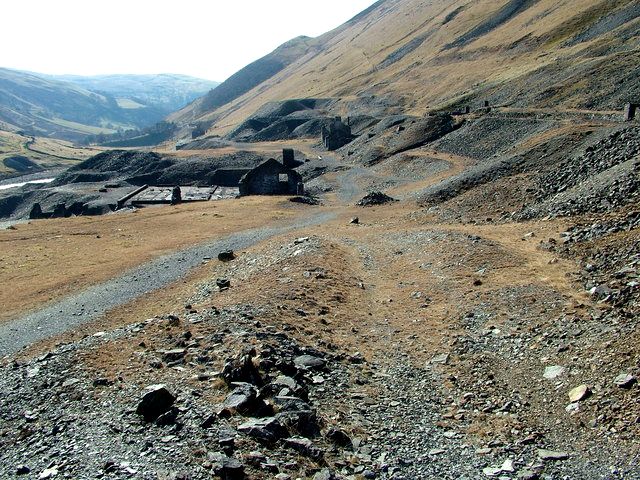
Cwmystwyth Mine
Copyright © Peter Evans and licensed for reuse under this Creative Commons Licence
The Cwmystwyth lodes are in alternating beds of hard gritstone and shales, in the Llandovery series of the Silurian period, which have been folded into synclines and anticlines. They are displaced by the Ystwyth fault, which has isolated ore bodies and caused “soft ground”. There are over thirty lodes, but the principal ones are the Comet, which is between 12 and 40 feet wide and has been the most productive, and the Kingside, which was three feet wide. They converged on Graifawr to produce a particularly rich ore-shoot, in places 60 feet wide.
It has always been said to be an ancient mine, and has produced evidence of some very early working in the last twenty years or so. It was being worked on a large scale during the monastic period, when it was controlled by Strata Florida Abbey.
John Leland visited Cwmystwyth around 1537 and described it as “a great digging for leade”. He also remarked that smelting “hath destroid the woodes that sometimes grew plentifully thereabout” which had been cut down for fuel.
Following a lengthy dispute about conflicting leases, the mines were worked by a variety of people in the early seventeenth century. These included Thomas Bushell and The Society of Mines Royal, but after parliament passed The Mines Royal Act in 1689 the company lost its monopoly and the Crown forfeited any claims on mines of lead, copper and tin regardless of silver content.
In 1704 the Company of Mines Adventurers of England, headed by Humphrey Mackworth, turned its attention to Cwmystwyth, and by 1708 had supposedly raised 581 tons of ore. Unfortunately the company was then convulsed by claims and counter-claims about who was responsible for its fraudulent management.
Chauncey Townsend leased the mine in 1759 and worked them until his death in 1770, when he was followed by his son, James, until 1785. Their manager Thomas Bonsall, of Bakewell in Derbyshire, then took over until his death in 1807. That span of nearly fifty years was one of the mine’s most prosperous times. A range of levels were driven and ore-bodies developed.
George and Thomas Alderson, two London Pewterers, who had the Old Gang Mine in Swaledale, together with James Raw, a Swaledale man, worked Cwmystwyth and Nanteos from 1822 to 1835. They opened a smelt mill at Devil’s Bridge in 1827, but the collapse in lead prices around 1830, and problems in getting out of their Old Gang lease, hit them badly and they were declared bankrupt in 1834. James Raw remained in Cwmystwyth, however, and served as manager under another three owners until his death in 1864.
Following the Alderson’s bad luck, their successor Lewis Pugh faired much better, especially from rising lead prices. John Taylor & Co., shareholders under Pugh, gained control of the mine from 1848. Output recovered to previous levels, but the miners were constantly troubled by the “old man” having been there before them. Compressed air drilling was installed in the 1870s in order to speed up development work and cut costs at a time of persistently low lead prices. Increasing amounts of zinc blende were also recovered at this time. Nevertheless, the mine closed at the end of 1885 and the company was restructured and limped on until late 1892, when it went into liquidation.
Henry Gammon floated the Cwmystwyth Mining Co. Ltd in 1898 and it poured money into the mine. A modern concentrating plant was built, electricity generators and compressors driven by water turbines were install. The mine was still troubled by “old man” workings, and output proved disappointing. A succession of small companies did no better and the mine had closed by 1940.
Hughes, S.J.S. The Cwmystwyth Mines (British Mining No.17, 1981)
Return to previous page
